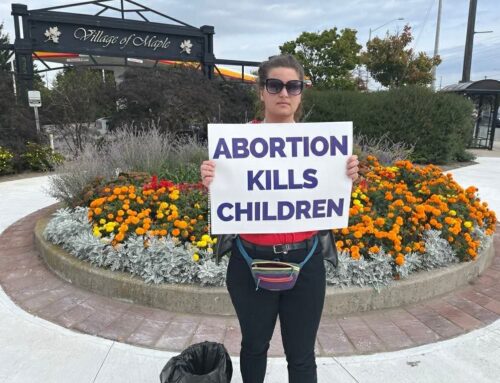I’ve previously heard that one of the disadvantages the pro-life movement has to contend with that other human rights campaigns haven’t had to is that unlike other historically oppressed groups like women and African Americans, the preborn cannot advocate for themselves. They can’t march. They can’t hold sit-in protests. There’s no civil disobedience in which they can participate from within the womb. They can’t directly confront those who dehumanize them with their own unmistakable humanity. We must do so for them.
Regrettably, while we do our best to make sure that they’re seen, by showing abortion victim photography, I don’t think it has quite the same emotional impact as being able to interact with these tiny humans our government and society have deemed non-human and unworthy of protection—as being able to befriend them, to debate them, to experience them.
Just recently, though, I was reminded that there is an important exception, of whom (if you’d pardon me) we should be taking full advantage: abortion survivors.
At the Washington, D.C., March for Life rally last month, the #facesofchoice ad premiered, featuring 14 survivors of failed abortions asking, “Can you look me in the eye and tell me I shouldn’t exist?” Needless to say, it’s pretty chilling. I would definitely recommend googling the video.
It was also scheduled to air during the Super Bowl, but the organization Faces of Choice was stonewalled by television network Fox, which, sadly, isn’t surprising. I spoke briefly to one of the abortion survivors included in the ad, Melissa Ohden, while I was in Washington, D.C., for the National Pro-Life Summit, and she said that when she testifies before various state and federal committees, she almost never gets any questions. You see, to preserve their psychological comfort, no pro-abortion politician can even acknowledge her existence.
Indeed, when I was at the United Nations’ Commission on the Status of Women a year ago, I talked with a student who was there on behalf of Planned Parenthood Michigan. I was asking her about her stance—just to see if there was any common ground to be found between us at all—and found out that she had never heard about children surviving an abortion.
Following our own 2019 National March for Life in Ottawa, I wrote in The Interimabout how I had finally come to fully appreciate the power of the narrative for the pro-life side in the abortion debate. The stories of abortion survivors, in particular, are among the most powerful.
They make it indisputable that the victims of abortion are real – not hypothetical. It was Josiah Presley’s arm that an abortionist maimed. It was Nik Hoot’s legs that were mutilated, his fingers left not fully developed. It was Claire Culwell’s twin who was murdered and her hips that ended up dislocated and feet that ended up clubbed. It is Gianna Jessen who has cerebral palsy thanks to an abortionist’s attempt to burn her alive in a saline abortion.
And what can pro-choicers say in answer? That had only those abortionists done their jobs better, these “unwanted” humans wouldn’t be here at all?
As I tell the students when I give Pro-Life 101 presentations, the very purpose of an abortion is to kill a human being. If you don’t end up with a dead baby at the end of that abortion procedure, it is considered a “failed” or “unsuccessful” abortion, and failed abortions do occur. Between 2013/2014 and 2017/2018, at least 766 infants were born alive following late-term abortions in Canada and presumably left to die. Ohden’s Abortion Survivors Network reportedly “had contact with 260 survivors of abortion or their friends or family who contacted (the Network) on their behalf” between 2012-2018.
Their stories have been used to strongly push for a Born-Alive Abortion Survivors’ Protection Act in the United States, which, if passed, would require physicians to provide medical care to infants born alive following a botched attempt to abort them and penalize those health care professionals who don’t. Democrats, predictably, have opposed this bill.
We should push for the same here in Canada, not because we have a greater chance of getting such legislation passed, but rather because we can win back precious rhetorical ground through doing so. Let’s flip the tables. Let’s force our ideological opponents to defend infanticide. Let them try to claim that failed abortions don’t happen, and let us, in turn, present them with the haunting faces of choice.





